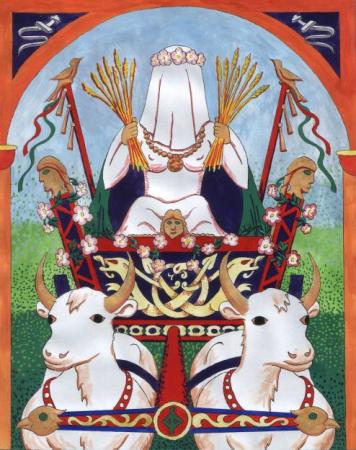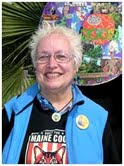The Venerable Bede (673–735), a Christian scholar and historian of Anglo-Saxon England who lived 200 years before Beowulf was written, describes the heathen beliefs and customs of his time. Because his interest is in converting the pagans, however, he says that Haligmonath is called “holy month” because that’s when “the heathens pay tribute to their devil.” The real reason the month is holy probably lies in the harvest and the thanksgiving feasts celebrated in honor of the gods and goddesses of the earth. Harvest Home (the final harvest) was celebrated in September in England and other lands.
 The Angles, Saxons, and Jutes were pre-Christian tribes who lived in northern Germany and the Baltic lands. The most famous leaders of the Jutes were Hengist and Horsa, whose names roughly translate as “horse” and “mare.” These Germanic tribes were invading and settling in Britain about the time King Arthur (or whoever the tribal chief was who was amalgamated into the medieval legends of Arthur) might have lived. This was during the fifth and sixth centuries, about the same time as the Merovingians (of Holy Blood Holy Grail fame) were ruling the Franks of Germany and France and St. Brigit (also the goddess Brigid) was founding her abbey in Cill Dara (known today as Kildare) in Ireland. Starting with Edward Gibbon’s History of the Decline and Fall of the Roman Empire (published ca. 1776), historians have been calling the centuries following the fall of the Rome the Dark Ages. This is when civilization somehow came to a halt, they say, and barbarian tribes galloped around looting and pillaging and destroying cities. Peter S. Wells disagrees. In his book, Barbarians to Angels: The Dark Ages Reconsidered, he writes that darkness did not fall upon the western world, knowledge and commerce did not disappear, cities were not destroyed and abandoned, and people did not sink into a miasma of ignorance. (There’s also an unintentionally hilarious movie starring Colin Firth and Ben Kingsley that describes the fall of Rome and the invention of King Arthur. In The Last Legion, Firth is a Roman knight who “rescues” the (real) last emperor of the Western Empire, a boy named Romulus Augustulus, and takes him to Britain. Kingsley turns out to be Merlin. I guess Firth just had to get the sword and sorcery bug out of his system.) A good novel set in the Dark Ages is Pope Joan by Donna Woolfolk Cross, which is set in the 9th century.
The Angles, Saxons, and Jutes were pre-Christian tribes who lived in northern Germany and the Baltic lands. The most famous leaders of the Jutes were Hengist and Horsa, whose names roughly translate as “horse” and “mare.” These Germanic tribes were invading and settling in Britain about the time King Arthur (or whoever the tribal chief was who was amalgamated into the medieval legends of Arthur) might have lived. This was during the fifth and sixth centuries, about the same time as the Merovingians (of Holy Blood Holy Grail fame) were ruling the Franks of Germany and France and St. Brigit (also the goddess Brigid) was founding her abbey in Cill Dara (known today as Kildare) in Ireland. Starting with Edward Gibbon’s History of the Decline and Fall of the Roman Empire (published ca. 1776), historians have been calling the centuries following the fall of the Rome the Dark Ages. This is when civilization somehow came to a halt, they say, and barbarian tribes galloped around looting and pillaging and destroying cities. Peter S. Wells disagrees. In his book, Barbarians to Angels: The Dark Ages Reconsidered, he writes that darkness did not fall upon the western world, knowledge and commerce did not disappear, cities were not destroyed and abandoned, and people did not sink into a miasma of ignorance. (There’s also an unintentionally hilarious movie starring Colin Firth and Ben Kingsley that describes the fall of Rome and the invention of King Arthur. In The Last Legion, Firth is a Roman knight who “rescues” the (real) last emperor of the Western Empire, a boy named Romulus Augustulus, and takes him to Britain. Kingsley turns out to be Merlin. I guess Firth just had to get the sword and sorcery bug out of his system.) A good novel set in the Dark Ages is Pope Joan by Donna Woolfolk Cross, which is set in the 9th century.
The Anglo-Saxon calendar is based on an agricultural year and the month names are as follows. Our information comes not only from Bede but also from Tacitus and from Norse and Germanic literature and customs.
Æfterra or Geola = January
Solmonath = February
Hrethmonath = March
Eostremonath = April
Thrimilci = May
Ærra or Litha = June
Æfterra or Litha = July
Weodmonath = August
Haligmonath = September
Winterfylleth = October
Blotmonath = November
Ærra or Geola = December
There are numerous modern groups who call themselves Asatru and heathen (but not pagan) and follow the paths of the old Norse and Germanic pantheons. If we look at the names of the months, we can see that March was “earth month,” April was “Easter month,” and August was “weeding [and harvesting] month.” Winter falls in October, when it gets cold in northern climes, and we celebrated November (“blood month”) by slaughtering cattle so we would have enough to eat all winter. Modern heathens hold festivals called blots.

Why was September called holy? Possibly because cereal crops (named for the Roman grain goddess Ceres) were harvested and stored in August and September, also so we’d have enough to eat during the winter. The Roman historian Tacitus says that some of the Germanic tribes honored the earth goddess in September. She had many names: Herta, Hertha, Nerthus, Holde, or simply Mother Earth. Her statue (usually carved wood) was taken from its temple or grove and set on a cart and pulled by yoked cows (not oxen) across the land for the people to see. No one except the priest (these were, remember, patriarchal times and tribes) was allowed to touch her.
It seems to me that with climate change and the true ruination of the earth nearly upon us, we should declare every month holy and whole planet holy, too. Let us honor our Mother Earth and live lightly upon her and keep her safe. We can accept her bountiful gifts (including the cereal crops) and take care to keep her—and us—green. Kermit was right, of course: it’s not easy being green. But we can remember the holiness of every day and every month and live greenly.
Barbara Ardinger, Ph.D. (www.barbaraardinger.com), is a published author and freelance editor. Her newest book is Secret Lives, a novel about grandmothers who do magic. Her earlier nonfiction books include the daybook Pagan Every Day, Finding New Goddesses (a pun-filled parody of goddess encyclopedias), and Goddess Meditations. When she can get away from the computer, she goes to the theater as often as possible—she loves musical theater and movies in which people sing and dance. She is also an active CERT (Community Emergency Rescue Team) volunteer and a member (and occasional secretary pro-tem) of a neighborhood organization that focuses on code enforcement and safety for citizens. She has been an AIDS emotional support volunteer and a literacy volunteer. She is an active member of the neopagan community and is well known for the rituals she creates and leads.



Hi Barbara, What an enjoyable piece! You mention that the Asatru are heathen, but not pagan. Can you clarify what makes this distinction? I also note that the Goddess depicted has a covered face. What is the significance of her veiling? Thanks, Karen
LikeLike
People I know who worship and honor the northern pantheons prefer “heathen” and Asatru to “pagan” to distinguish themselves from the softer modern adherents of the classical Mediterranean pantheons. Members of other non-standard-brand religions (like Buddhists and Hindus and Native Americans) also do not refer to themselves as pagans. Me, I like spiritual feminist, but that takes more explaining than “pagan” or “witch.” And of course not all witches are Wiccans. Yeah. We’re as complex as the Christian denominations.
LikeLike
Come ye thankful people come,
Raise a song of harvest home,
All is safely gathered in,
E’re the winter storms begin.
Goddess Mother* does provide,
All our wants to be supplied,
Come ye thankful people come,
Raise a song of harvest home.
*or God our Mother
LikeLike
Thanks, Carol. I love this. It’s like my revisionist Christmas carols (“Joy to the world, the Light is born”) and my version of “Let there by peace on earth”–“With Goddess our Mother, kindred all are we….”
LikeLike
Thank you for all this information! I loved learning new things about the month I was born in.
LikeLike
Thank you for this wealth of information on one of my favorite months of the year–though I totally agree the whole round of the year is holy, all seasons, all daily, nightly, moment to moment miraculous changes.
LikeLike
Thanks for this lovely piece on this time of year, which was so important to our ancestors. If one September didn’t go well for them, there may not have been another. This month is also a holy month for Jews, as we celebrate the High Holy Days, similarly named. Your article adds depth to my understanding of what was originally a harvest festival as well. We implore god(ess) to inscribe our names in the book of life for another year. We then ask that the book be sealed (with our names in it) for the year. Happy Heligmonath!!!
LikeLike
Your writing inspired me to look up the lyrics to “It’s Not Easy Being Green”, and it is delightful. After a couple of stanzas of lamenting how he blends into everything, Kermit sings:
But green’s the color of Spring
And green can be cool and friendly-like
And green can be big like an ocean, or important
Like a mountain, or tall like a tree
When green is all there is to be
It could make you wonder why, but why wonder why
Wonder, I am green and it’ll do fine, it’s beautiful
And I think it’s what I want to be
(I think it’s what I want to be too, Kermit.)
And it was so nice to discover that Lithia is the name for June, and Lithia Park is where I walk, and Lithia Springs is nearby too. It makes me feel at home.
LikeLike
I have been a fan of and adored Kermit ever since the first time I saw him on “Sesame Street” when my son was in kindergarten. I also love the Muppet movies. I even like The Pig. I gave her a day in Pagan Every Day and put the best pun in the whole book on her page. In what state are Lithia Park and Lithia Springs?
LikeLike